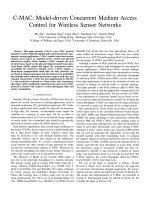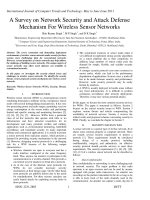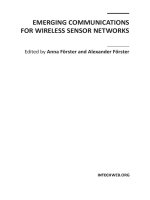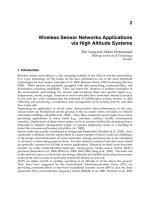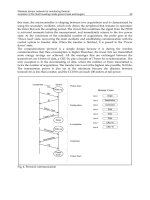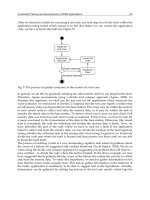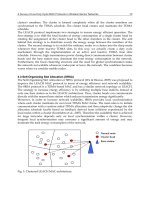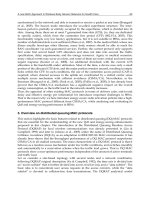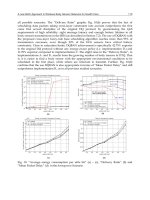Efficient data dissemination and collection protocols for wireless sensor networks
Bạn đang xem bản rút gọn của tài liệu. Xem và tải ngay bản đầy đủ của tài liệu tại đây (820.06 KB, 134 trang )
Efficient Data Dissemination and Collection Protocols
for Wireless Sensor Networks
Manjunath Doddavenkatappa
SCHOOL OF COMPUTING
NATIONAL UNIVERSITY OF SINGAPORE
2013
Efficient Data Dissemination and Collection Protocols
for Wireless Sensor Networks
Manjunath Doddavenkatappa
A THESIS SUBMITTED
FOR THE DEGREE OF PhD IN COMPUTER SCIENCE
SCHOOL OF COMPUTING
NATIONAL UNIVERSITY OF SINGAPORE
2013
Declaration
I hereby declare that this thesis is my original work and it has been written by me in its entirety.
I have duly acknowledged all the sources of information which have been used in the thesis.
This thesis has also not been submitted for any degree in any university previously.
Manjunath Doddavenkatappa
7
th
October, 2013
Acknowledgements
I first and foremost thank my advisor Prof. Chan Mun Choon for his invaluable guidance and all
the support that he has rendered throughout my graduate studies. I can recall many occasions
during paper deadlines, we working at as late as 5 AM in the morning, which speaks itself for
his commitment. I am most grateful to him for his efforts in nurturing my research skills and
critical thinking.
I am grateful to Prof. Ananda, he was always there for everything. His simplicity makes
him special. I thoroughly enjoyed our lunch-time discussions that mainly included a topic of
spirituality. I thank the inspiring Prof. Ben Leong for his collaboration on my work. I am most
thankful to him for his guidance on improving my writing skills, I can recall he sitting with me
and working on it for long hours.
Many thanks to many users of Indriya testbed, their warming words kept my motivation
levels always high to maintain Indriya. I also thank our own CS 4222 students for their questions
and bug reports which have greatly contributed to the stability of Indriya.
I am grateful to our wireless meeting group: Prof. Wei Tsang ooi, Prof. Jason Gu, Wang Wei,
Guoqing Yu, and James Yong. A special thanks to Ms. Lim Chew Eng from technical services,
without her help I would not have had as an easy access as I had to project equipments. Thanks
to all my friends in our lab for their friendship and support: Bhojan Anand, Chetan, Grisha,
Hweexian, Kartik, Mustafa, Naba, Shao Tao, and Xiangfa. Thanks also to Sudipta for his
friendship. I would also like to thank my friends who helped and supported me during my pre-
iii
university and undergraduate studies: Vilas Reddy Chuda, Srinivas Kapilavai, and Gangadhar
Reddy.
I never would have been eligible to join a PhD program if I had not met Prasanna Kumar,
who was my mentor during my one-year training at the Defense Research and Development
Organization of India (DRDO). I am most grateful to him for introducing me to Sai Baba. I also
thank S.V Gopalaiah and SVR Anand, who were my mentors when I was working at the Indian
Institute of Science (IISc), they have always encouraged me to take challenging tasks.
Finally, I dedicate this dissertation to my wife, Namitha. I have no words to describe her
support throughout my graduate studies, I just want to thank God for blessing me with such a
wonderful person as my life partner.
Contents
Abstract iv
List of Tables vi
List of Figures vii
List of Publications viii
1 Introduction 1
1.1 Wireless Sensor Networks . . . . . . . . . . . . . . . . . . . . . . . . . . . . 1
1.2 Case for Dissemination of Large Data Objects . . . . . . . . . . . . . . . . . . 2
1.3 Case for Collection of Large Data Objects . . . . . . . . . . . . . . . . . . . . 3
1.4 Overview of the Proposed Protocols . . . . . . . . . . . . . . . . . . . . . . . 5
1.4.1 Splash: Fast Data Dissemination . . . . . . . . . . . . . . . . . . . . . 5
1.4.2 ILTP: Transforming Intermediate Quality Links into Good Links . . . . 6
1.4.3 P
3
: Practical Packet Pipelining . . . . . . . . . . . . . . . . . . . . . . 7
1.5 Contributions . . . . . . . . . . . . . . . . . . . . . . . . . . . . . . . . . . . 8
1.6 Thesis Structure . . . . . . . . . . . . . . . . . . . . . . . . . . . . . . . . . . 10
2 Related Work and Background 11
2.1 Constructive Interference . . . . . . . . . . . . . . . . . . . . . . . . . . . . . 11
2.2 Channel Diversity . . . . . . . . . . . . . . . . . . . . . . . . . . . . . . . . . 13
2.3 Dissemination Protocols . . . . . . . . . . . . . . . . . . . . . . . . . . . . . 14
2.4 Bulk Data Collection . . . . . . . . . . . . . . . . . . . . . . . . . . . . . . . 15
2.4.1 Opportunistic Routing . . . . . . . . . . . . . . . . . . . . . . . . . . 16
2.4.2 High-Throughput Bulk Data Collection Protocols . . . . . . . . . . . . 17
2.4.3 Collection Tree Protocol (CTP) . . . . . . . . . . . . . . . . . . . . . 18
2.5 Methods for Handling Channels-Quality Differences . . . . . . . . . . . . . . 19
2.6 Correlation among Packet Receptions . . . . . . . . . . . . . . . . . . . . . . 19
2.7 Practical Testbeds . . . . . . . . . . . . . . . . . . . . . . . . . . . . . . . . . 20
3 Splash: Fast Data Dissemination 22
3.1 Introduction . . . . . . . . . . . . . . . . . . . . . . . . . . . . . . . . . . . . 22
3.2 Measurement Study of Constructive Interference . . . . . . . . . . . . . . . . 26
CONTENTS ii
3.2.1 Scalability . . . . . . . . . . . . . . . . . . . . . . . . . . . . . . . . 26
3.2.2 Receiver Correlation . . . . . . . . . . . . . . . . . . . . . . . . . . . 28
3.3 Splash Protocol . . . . . . . . . . . . . . . . . . . . . . . . . . . . . . . . . . 30
3.3.1 Tree Pipelining . . . . . . . . . . . . . . . . . . . . . . . . . . . . . . 31
3.3.2 Channel Cycling & Channel Assignment . . . . . . . . . . . . . . . . 34
3.3.3 Exploiting Transmission Density Diversity . . . . . . . . . . . . . . . 35
3.3.4 XOR Coding . . . . . . . . . . . . . . . . . . . . . . . . . . . . . . . 36
3.3.5 Local Recovery . . . . . . . . . . . . . . . . . . . . . . . . . . . . . . 38
3.3.6 Implementation . . . . . . . . . . . . . . . . . . . . . . . . . . . . . . 38
3.4 Performance Evaluation of Splash . . . . . . . . . . . . . . . . . . . . . . . . 41
3.4.1 Experimental Methodology . . . . . . . . . . . . . . . . . . . . . . . 41
3.4.2 Summary of Testbed Results . . . . . . . . . . . . . . . . . . . . . . . 42
3.4.3 Contribution of Individual Techniques . . . . . . . . . . . . . . . . . . 46
3.4.4 Effect of Packet Size . . . . . . . . . . . . . . . . . . . . . . . . . . . 51
3.5 Summary . . . . . . . . . . . . . . . . . . . . . . . . . . . . . . . . . . . . . 53
4 ILTP: Transforming Intermediate Quality Links into Good Links 54
4.1 Introduction . . . . . . . . . . . . . . . . . . . . . . . . . . . . . . . . . . . . 54
4.2 Measurement Study of Channels on IQ Links . . . . . . . . . . . . . . . . . . 58
4.2.1 Collection of Traces . . . . . . . . . . . . . . . . . . . . . . . . . . . 58
4.2.2 Correlation among Different Channels . . . . . . . . . . . . . . . . . . 59
4.2.3 Rate of Fluctuation of Channel Quality . . . . . . . . . . . . . . . . . 60
4.2.4 How Easy is it to Find a Good Channel? . . . . . . . . . . . . . . . . . 60
4.3 ILTP Protocol . . . . . . . . . . . . . . . . . . . . . . . . . . . . . . . . . . . 64
4.3.1 ILTP for Bulk Data Collection . . . . . . . . . . . . . . . . . . . . . . 64
4.3.2 An Efficient Channel Selection Strategy . . . . . . . . . . . . . . . . . 65
4.3.3 Coordinating Channel Switching . . . . . . . . . . . . . . . . . . . . . 67
4.3.4 Implementation . . . . . . . . . . . . . . . . . . . . . . . . . . . . . . 69
4.4 Performance Evaluation of ILTP . . . . . . . . . . . . . . . . . . . . . . . . . 74
4.4.1 Experimental Methodology . . . . . . . . . . . . . . . . . . . . . . . 74
4.4.2 Transformation of IQ Links into Good Links using ILTP . . . . . . . . 74
4.4.3 Channel Durations . . . . . . . . . . . . . . . . . . . . . . . . . . . . 75
4.4.4 Overhead . . . . . . . . . . . . . . . . . . . . . . . . . . . . . . . . . 76
4.4.5 Improvement in Routing Performance . . . . . . . . . . . . . . . . . . 77
4.4.6 Effect of Packet Rate . . . . . . . . . . . . . . . . . . . . . . . . . . . 79
4.4.7 Periodic Traffic over a Duty-Cycling MAC . . . . . . . . . . . . . . . 80
4.5 Summary . . . . . . . . . . . . . . . . . . . . . . . . . . . . . . . . . . . . . 82
5 P
3
: Practical Packet Pipelining 83
5.1 Introduction . . . . . . . . . . . . . . . . . . . . . . . . . . . . . . . . . . . . 83
5.2 Measurement Study of Channels-Quality Differences . . . . . . . . . . . . . . 87
5.2.1 Channels-Quality Differences . . . . . . . . . . . . . . . . . . . . . . 87
5.2.2 Correlation among Packet Receptions . . . . . . . . . . . . . . . . . . 89
CONTENTS iii
5.3 P
3
Protocol . . . . . . . . . . . . . . . . . . . . . . . . . . . . . . . . . . . . 92
5.3.1 PIP Pipelining . . . . . . . . . . . . . . . . . . . . . . . . . . . . . . 92
5.3.2 Practical Packet Pipelining with Constructive Interference . . . . . . . 92
5.3.3 Routing . . . . . . . . . . . . . . . . . . . . . . . . . . . . . . . . . . 95
5.3.4 Channel Assignment . . . . . . . . . . . . . . . . . . . . . . . . . . . 96
5.3.5 Scalability at the Last Stage . . . . . . . . . . . . . . . . . . . . . . . 97
5.3.6 Fast Retransmissions . . . . . . . . . . . . . . . . . . . . . . . . . . . 97
5.3.7 Implementation . . . . . . . . . . . . . . . . . . . . . . . . . . . . . . 98
5.4 Performance Evaluation of P
3
. . . . . . . . . . . . . . . . . . . . . . . . . . 101
5.4.1 Experimental Methodology . . . . . . . . . . . . . . . . . . . . . . . 101
5.4.2 Summary of Testbed Results . . . . . . . . . . . . . . . . . . . . . . . 102
5.4.3 Effective Utilization . . . . . . . . . . . . . . . . . . . . . . . . . . . 103
5.4.4 Effect of Packet Size . . . . . . . . . . . . . . . . . . . . . . . . . . . 105
5.5 Summary . . . . . . . . . . . . . . . . . . . . . . . . . . . . . . . . . . . . . 107
6 Conclusion and Future Work 108
6.1 Research Contributions . . . . . . . . . . . . . . . . . . . . . . . . . . . . . . 108
6.1.1 Splash: Fast Data Dissemination . . . . . . . . . . . . . . . . . . . . . 109
6.1.2 ILTP: Transforming Intermediate Quality Links into Good Links . . . . 109
6.1.3 P
3
: Practical Packet Pipelining . . . . . . . . . . . . . . . . . . . . . . 110
6.1.4 Correlation . . . . . . . . . . . . . . . . . . . . . . . . . . . . . . . . 110
6.2 Future Work . . . . . . . . . . . . . . . . . . . . . . . . . . . . . . . . . . . . 111
Bibliography 114
Abstract
Dissemination and collection of large amounts of data are two fundamental services required in
wireless sensor networks. Despite almost a decade of research, existing large data dissemination
and collection protocols still take long completion times and consume a significant amount
of energy. This is due to the effects of various issues: contention overhead, intra- and inter-
flow interferences, external interference, link asymmetry, varying channel conditions, channels-
quality differences, and/or energy-intensive requirements such as packet overhearing.
In this work, we effectively handle these issues by exploiting constructive interference and
channel diversity, in addition to using various techniques such as exploiting transmission den-
sity diversity and node diversity, XOR coding, channel cycling, etc. This leads us to make
three important contributions, which constitute this dissertation: (1) We design and implement
Splash, a data dissemination protocol that is more than an order of magnitude faster than state-
of-the-art dissemination protocols. (2) We propose a new approach that allows data collection
protocols to exploit long-range communication links of intermediate quality (IQ) through chan-
nel diversity with a new protocol, called ILTP (IQ Link Transformation Protocol), which does
not require an energy-intensive operation of packet overhearing. (3) We design and implement
P
3
(Practical Packet Pipeline), a high-throughput data collection protocol that on average uti-
lizes 84.2% of the effective data rate of the underlying de facto standard CC2420 radio, whereas
average utilization for the state-of-the-art high-throughput protocol is only 16.2%.
Splash. It is well-known that the time taken for disseminating a large data object over a
wireless sensor network is dominated by the overhead of resolving the contention for the under-
lying wireless channel. On the other hand, Splash eliminates the need for contention resolution
by exploiting constructive interference and channel diversity to effectively create fast and par-
allel packet pipelines over multiple paths that cover all the nodes in a network. We call this
tree pipelining. In order to ensure high reliability, Splash also incorporates several techniques,
including exploiting transmission density diversity, opportunistic overhearing, channel cycling,
and XOR coding. Our evaluation results on two large-scale testbeds show that Splash is more
than an order of magnitude faster than state-of-the-art dissemination protocols and achieves a
CONTENTS v
reduction in data dissemination time by a factor of more than 20 compared to the most com-
monly used DelugeT2.
ILTP. A large percentage of links in low-power wireless sensor networks are of intermediate
quality (IQ). Opportunistic exploitation is currently the only way to exploit longer range offered
by these links. However, such exploitation requires packet overhearing which consumes a sig-
nificant amount of energy. Whereas ILTP takes a novel approach of exploiting IQ links through
channel diversity, which does not require packet overhearing. ILTP transforms IQ links into
good links thus allowing us to exploit such links continuously rather than using them only op-
portunistically. Our evaluations on three large-scale testbeds demonstrate that ILTP is able to
consistently transform the IQ links into good links. When ILTP is integrated with CTP, the
default data collection protocol for sensor networks, the average number of transmissions per
end-to-end packet delivery is reduced by 24-58%, without incurring any overhearing energy
costs.
P
3
. While state-of-the-art large data collection protocol (PIP (Packets In Pipeline)) exploits
channel diversity to create a fast packet pipeline, it ignores the drastic performance differences
that exist among different channels – there exists a high chance that a good link on one chan-
nel not even existing on another channel. Such differences significantly degrade throughput by
causing pipeline stalls. On the other hand, P
3
keeps its packet pipeline flowing despite substan-
tial quality differences among different channels. In order to do so, P
3
exploits node diversity
on both senders and receivers through constructive interference. Moreover, unlike existing ap-
proaches whose maximum achievable goodput is half of the effective data rate of an underlying
radio device, P
3
can achieve a maximum goodput that is equal to the effective data rate. Our
evaluation results on a 139-node practical testbed show that P
3
achieves an average goodput
of 177.8 Kbps while PIP’s average goodput is only 35.6 Kbps. More importantly, P
3
achieves
an average goodput of about 179.3 Kbps in cases where goodput of PIP reduces to zero which
happens often in practice.
Overall, in this dissertation, we design and implement efficient large data dissemination and
collection protocols for wireless sensor networks, which outperform state-of-the-art protocols
by a large margin.
List of Tables
3.1 Correlation coefficients observed on Channel 26. . . . . . . . . . . . . . . . . 29
3.2 Correlation coefficients observed on Channel 22. . . . . . . . . . . . . . . . . 29
3.3 Summary of results for 139-node Indriya testbed. . . . . . . . . . . . . . . . . 43
3.4 Summary of results for 90-node Twist testbed. . . . . . . . . . . . . . . . . . . 44
3.5 Comparison of Splash to existing protocols. . . . . . . . . . . . . . . . . . . . 45
3.6 Proportion of 100%-reliability nodes before and after XOR coding. . . . . . . . 47
3.7 Performance of Splash with and without opportunistic overhearing. . . . . . . . 49
3.8 Performance of Splash with and without channel cycling. . . . . . . . . . . . . 50
3.9 Performance of Splash for two different payload sizes. . . . . . . . . . . . . . 52
4.1 Correlation coefficient matrix of PRR observed on an IQ link. . . . . . . . . . 59
4.2 Percentage of leaf nodes on CTP trees in different testbeds. . . . . . . . . . . . 72
4.3 Performance of ILTP over duty-cycling BoX-MAC. . . . . . . . . . . . . . . . 80
5.1 Quality differences among different channels on links of Channel 26. . . . . . . 88
5.2 Quality differences among different channels on links of Channel 20. . . . . . . 89
5.3 Correlation matrix observed on Channel 26. . . . . . . . . . . . . . . . . . . . 90
5.4 Correlation matrix observed on Channel 25. . . . . . . . . . . . . . . . . . . . 90
5.5 Correlation matrix observed on Channel 20. . . . . . . . . . . . . . . . . . . . 91
5.6 Correlation matrix observed on Channel 15. . . . . . . . . . . . . . . . . . . . 91
List of Figures
3.1 Plot of reliability against the number of concurrent senders. . . . . . . . . . . . 27
3.2 Illustration of pipelining over a tree. . . . . . . . . . . . . . . . . . . . . . . . 31
3.3 Packet format used in Splash. . . . . . . . . . . . . . . . . . . . . . . . . . . . 34
3.4 Channel assignment. . . . . . . . . . . . . . . . . . . . . . . . . . . . . . . . 35
3.5 Contribution of XOR coding. . . . . . . . . . . . . . . . . . . . . . . . . . . . 48
3.6 Contribution of transmission density diversity. . . . . . . . . . . . . . . . . . . 48
3.7 Evaluation of Local Recovery. . . . . . . . . . . . . . . . . . . . . . . . . . . 51
3.8 Comparison of Splash against DelugeT2 for different payload sizes. . . . . . . 52
4.1 Plot of PRR of different channels under parallel transmissions. . . . . . . . . . 60
4.2 Observations during emulation of transformation of IQ links. . . . . . . . . . . 62
4.3 Choice of values for CST and PRRWND. . . . . . . . . . . . . . . . . . . . . 62
4.4 Behavior of poor channels on an IQ link in Indriya. . . . . . . . . . . . . . . . 65
4.5 Operation of ILTP. . . . . . . . . . . . . . . . . . . . . . . . . . . . . . . . . 70
4.6 Routing progress offered by IQ links. . . . . . . . . . . . . . . . . . . . . . . 71
4.7 Transformation of IQ links on different testbeds using ILTP. . . . . . . . . . . 75
4.8 Time spent in different channels during transformation using ILTP. . . . . . . . 76
4.9 Two different methods to identify and filter poor channels. . . . . . . . . . . . 77
4.10 Routing progress offered by ILTP on different testbeds. . . . . . . . . . . . . . 78
4.11 Performance of ILTP at different inter-packet intervals. . . . . . . . . . . . . . 79
5.1 Problem and the proposed solution. . . . . . . . . . . . . . . . . . . . . . . . . 93
5.2 P
3
’s packet pipeline achieving the maximum possible end-to-end throughput. . 94
5.3 Goodput comparison between P
3
and PIP. . . . . . . . . . . . . . . . . . . . . 103
5.4 Effective data rate of CC2420 Radio. . . . . . . . . . . . . . . . . . . . . . . . 104
5.5 End-to-end effective utilization of P
3
. . . . . . . . . . . . . . . . . . . . . . . 105
5.6 Goodput of P
3
for different packet payload sizes. . . . . . . . . . . . . . . . . 105
List of Publications
(1) Manjunath Doddavenkatappa and Mun Choon Chan, “P
3
: A Practical Packet Pipeline
using Constructive Interference for Wireless Sensor Networks,” Under Submission.
(2) Manjunath Doddavenkatappa, Mun Choon Chan, and Ben Leong, “Splash: Fast Data Dis-
semination with Constructive Interference in Wireless Sensor Networks,” In Proceedings
of 10
th
USENIX Symposium on Networked Systems Design and Implementation (NSDI),
April 2013.
(3) Manjunath Doddavenkatappa, Mun Choon Chan, and Ben Leong, “Improving Link Qual-
ity by Exploiting Channel Diversity in Wireless Sensor Networks,” In Proceedings of
32
nd
IEEE Real-Time Systems Symposium (RTSS), November 2011.
(4) Manjunath Doddavenkatappa, Mun Choon Chan, and Ananda A L, “A Dual-Radio Frame-
work for MAC Protocol Implementation in Wireless Sensor Networks,” In Proceedings
of International Conference on Communications (ICC), June 2011.
(5) Manjunath Doddavenkatappa, Mun Choon Chan, and Ananda A L, “Indriya: A Low-
Cost, 3D Wireless Sensor Network Testbed,” In Proceedings of 7
th
International ICST
Conference on Testbeds and Research Infrastructures for the Development of Networks
and Communities (TRIDENTCOM), April 2011.
Chapter 1
Introduction
1.1 Wireless Sensor Networks
Wireless networks of tiny embedded devices commonly known as wireless sensor networks
have numerous applications, ranging from monitoring of serene habitats of birds to turbulent
volcanos [
1, 2, 3, 4, 5, 6, 7, 8, 9, 10, 11]. Moreover, a paradigm of Internet of Things makes
sensor networks truly pervasive, by connecting almost everything to the Internet [12]. While
extremely useful, sensor networks are equally challenging due to extreme resource constraints.
A sensor device is typically constrained by most of its components, among which, energy is the
paramount issue as it decides the lifetime of a sensor network.
Given the fact that communication consumes significant energy [
13], most of the sensor net-
work research focus on designing efficient communication protocols. Typically, communication
in sensor networks is a part of either data dissemination or collection. Dissemination service in-
volves disseminating large data objects to the entire network and it is required for almost every
application of sensor networks. Similarly, a service that collects large amount of data from a
network is also of similar significance. Because of their importance, both of these services have
received much attention in the research community [14, 15, 16, 17, 18, 19, 20, 21, 22, 23, 24].
1.2 Case for Dissemination of Large Data Objects 2
However, despite such an attention, performance of these existing bulk data dissemination and
collection protocols is often poor in practice, taking long completion times and consuming a
significant amount of energy. This is due to the effects of various issues: contention over-
head, intra- and inter-flow interferences, external interference, link asymmetry, varying channel
conditions, channels-quality differences, and/or energy-intensive requirements such as packet
overhearing.
The focus of the work in this dissertation is to effectively tackle these issues that affect
the performance of fundamental services of large data dissemination and collection in sensor
networks. We show that we can do so, by exploiting constructive interference and channel di-
versity, in addition to using various techniques such as exploiting transmission density diversity
and node diversity, XOR coding, channel cycling, etc.
1.2 Case for Dissemination of Large Data Objects
Dynamic reprogramming that involves dissemination of executable programs that are typically
large is a capability that is required throughout the life of almost all sensor-network applica-
tions [25]: (1) During software development, which is a cyclic process where code is updated
and tested in a cycle. Every time an update has to be tested, an underlying test network has to
be reprogrammed. (2) Before deploying an application in the field, a dissemination protocol is
critical to facilitate application’s evaluation on testbeds representing realistic environments. (3)
To correct software bugs, it is common to encounter new bugs in deployed systems, a buggy
program has to be corrected and the underlying network must be reprogrammed with the cor-
rected executable image. (4) During operation of an adaptive application such as fire detection
and rescue, an executable program has to be disseminated as a response to the occurrence of an
event [
26].
A fast dissemination protocol is desired in all the above scenarios because: (1) Energy
1.3 Case for Collection of Large Data Objects 3
consumption of a dissemination protocol is typically directly proportional to its dissemination
time. This means the smaller the dissemination time the lesser the energy consumption. (2) A
fast dissemination protocol can significantly shorten software development time as development
typically involves a large number of small changes and their testing [
25]. (3) Smaller dissemina-
tion times are important as otherwise developers get frustrated with long waiting times incurred
in program installations; every time a change has to be testbed, there will be the waiting time.
(4) Dissemination speed is also critical for adaptive applications as the faster the program dis-
semination the sooner the response to an event can be initiated.
Due to issues such as contention overhead, interference, link asymmetry, and varying chan-
nel conditions, dissemination times of existing dissemination protocols are at least in the order
of minutes. On the other hand, in this work, we propose a new dissemination protocol called
Splash, which does not require contention resolution and incorporates techniques to effectively
handle the other issues. Compared to existing protocols, Splash reduces dissemination time by
an order of magnitude, from minutes to seconds.
1.3 Case for Collection of Large Data Objects
Generating data in bulk is intrinsic to several sensor-network applications such as monitoring
of active volcanos, structural health, wildlife [
2, 3, 4, 5, 11], and to acoustic/imaging applica-
tions [6, 7, 8]. Moreover, a model in which nodes sense and store the sensed data locally for
later transfer in a bulk is an attractive option in general for non-realtime sensor applications
such as soil monitoring studies [
9, 27], environmental monitoring [28, 29], and energy audit-
ing [
10]. This is because such a model allows to achieve an ultra-low power consumption for
such applications [30].
Therefore, a protocol for collecting the generated bulk data is mandatory for all these ap-
plications. The state-of-the-art bulk data collection protocol that specifically targets energy
1.3 Case for Collection of Large Data Objects 4
efficiency is BRE [31]. While it adopts opportunistic transmissions [32] over long-range in-
termediate quality links (links with 0.1 ≤ P RR ≤ 0.9, abbreviated as IQ links) as the key
energy-saving technique, BRE fails to save energy in practice. This is because opportunistic
transmissions require packet overhearing which consumes significantly more energy than the
gain that is rendered by the transmissions over long-range links. Whereas in this work, we
propose a new approach to exploit long-range IQ links through channel diversity with a new
protocol, called ILTP (IQ Link Transformation Protocol), which does not require packet over-
hearing.
In addition to energy efficiency, high throughput in bulk data collection is also important
for three key reasons. (1) High throughput reduces event miss rate [
11, 23]. Sensor nodes in
applications such as volcano monitoring [
11] are required to suspend their event sampling dur-
ing data transfer in order to avoid overwriting of the local flash memory [
11]. This means the
higher the data transfer throughput the sooner the nodes can resume sampling, thus allowing
nodes to capture back-to-back events which is a key application requirement. (2) For applica-
tions such as structural health monitoring [
2, 3, 4], while higher sampling rates and collection
of large amounts of structural vibration data is key for accurate analysis [
2], time slots available
for uploading collected data are usually short as in an application of railway bridge monitor-
ing [
3] where data is uploaded on to passing trains. Thus high throughput allows gathering and
uploading of more data in the available interval of time. (3) High throughput can also reduce
energy consumption as nodes can complete data transfer faster and they can go back to sleep
for energy conservation [
23].
The state-of-the-art protocol to achieve high throughput in bulk data collection is PIP (Pack-
ets In Pipeline) [
23], that exploits channel diversity as its key in achieving a high throughput.
However, due to drastic performance differences that exist among different channels, PIP’s per-
formance is often poor in practice. In order to tackle this problem, we propose a new protocol
called P
3
(Practical Packet Pipeline), that ensures a high throughput despite substantial quality
1.4 Overview of the Proposed Protocols 5
differences among different channels.
1.4 Overview of the Proposed Protocols
Following is an overview of the three protocols of Splash, ILTP, and P
3
which are designed and
implemented in this work.
1.4.1 Splash: Fast Data Dissemination
A data dissemination protocol, like Deluge [
21], is a fundamental service required for the de-
ployment and maintenance of practical wireless sensor networks because of the need to pe-
riodically reprogram sensor nodes in the field. Existing data dissemination protocols employ
either a contention based MAC protocol like CSMA/CA [
14, 15, 16, 17, 19, 20, 21, 33] or
TDMA [
34] for resolving the multiple access problem of the wireless channel. As there is a
large amount of data that needs to be disseminated to all the nodes in the network, there is often
severe contention among the many transmissions from many nodes. Existing MAC protocols
incur significant overhead in contention resolution, and it has been shown that Deluge can take
as long as an hour to program a 100-node sensor network [
35].
On the other hand, Splash completely eliminates contention overhead by exploiting con-
structive interference and channel diversity. Splash is scalable to large, multi-hop sensor net-
works and it is built upon two recent works: Glossy [
36] and PIP [23]. Glossy uses construc-
tive interference in practical sensor networks to enable multiple senders to transmit the same
packet simultaneously, while still allowing multiple receivers to correctly decode the transmitted
packet. Like Glossy, we eliminate the overhead incurred in contention resolution by exploiting
constructive interference. Raman et al. showed in PIP that a pipelined transmission scheme
exploiting channel diversity can avoid self interference and maximize channel utilization for a
single flow over multiple hops by ensuring that each intermediate node is either transmitting
1.4 Overview of the Proposed Protocols 6
or receiving at any point of time. Splash uses constructive interference to extend this approach
to tree pipelining, where each level of a dissemination tree serves as a stage of the pipeline,
allowing multiple packet flows to operate in parallel without intra- and inter-flow interferences.
We implemented Splash in Contiki-2.5 [
37] and we evaluated the protocol on the Indriya
testbed [
38] with 139 nodes and the Twist testbed [39] with 90 nodes. We compare Splash to
both Deluge [21] in Contiki and to the much improved DelugeT2 implemented in TinyOS [40,
41]. As we use DelugeT2 as a baseline, it allows us to compare Splash to many of the existing
dissemination protocols in the literature as most of them are also compared to Deluge. Our
results show that Splash is able to disseminate a 32-kilobyte data object in about 25 seconds on
both the testbeds. Compared to DelugeT2, Splash reduces dissemination time on average by
a factor of 21, and in the best case, by up to a factor of 57.8. This is significantly better than
MT-Deluge [
16], the best state-of-the-art dissemination protocol, which achieves a reduction
factor of only 2.42 compared to Deluge.
1.4.2 ILTP: Transforming Intermediate Quality Links into Good Links
While IQ links are deemed too unstable by existing routing metrics, such links typically have
longer range than good quality links. There is a potential for significant energy savings if
these IQ links can be used for bulk data collection. In fact, some approaches to exploit such
links to improve routing performance have been proposed [
31, 32]. However, these approaches
require nearby nodes to perform overhearing even if they are not the intended recipients. Such
overhearing consumes a significant amount of energy, thus limiting the achievable gain.
ILTP allows to exploit IQ links without packet overhearing. ILTP effectively transforms IQ
links into good quality links by exploiting channel diversity. By transformation, we mean that
given a link whose quality is intermediate on a single channel (typically, the default Channel 26),
ILTP ensures good quality (PRR > 0.9) on the same link by making timely switchings among
different channels that are not positively correlated. Such transformation of an IQ link into a
1.4 Overview of the Proposed Protocols 7
good link means its quality fluctuations are avoided. This eliminates the need for overhearing as
otherwise required to identify the good phases of the quality fluctuations and allows transformed
links to be exploited continuously rather than only opportunistically.
ILTP is based on two key observations that we found in our measurement studies. First,
there is very little correlation in the quality of an IQ link across different ZigBee channels. In
more than 80% of the cases, the correlation coefficient for the link quality between any two
channels on the same IQ link is either negative or below 0.1. Second, it is common to find
sufficient number of channels for an IQ link, which change in quality on the time scale of a few
minutes, so that the underlying IQ link can be transformed into a good link by switching among
such channels once every few minutes.
We demonstrate the utility of ILTP by integrating it with CTP [42], the default collection
tree routing protocol for TinyOS. ILTP allows CTP to use IQ links as parts its routes and exploit
their longer range continuously. We evaluate ILTP and its integration with CTP on three large-
scale testbeds, namely: Motelab [
43], Twist [39], and Indriya [38] and show that ILTP is able
to consistently transform IQ links into good links. We observe that even a poor link with a PRR
0.05 can be transformed into a good link with a PRR greater than 0.9. With ILTP integrated,
the average number of transmissions per end-to-end packet delivery for CTP routes is reduced
by 24-58%, without incurring any overhearing energy costs.
1.4.3 P
3
: Practical Packet Pipelining
The state-of-the-art protocol to achieve high throughput in bulk data collection is PIP (Packets
In Pipeline) [
23], which exploits channel diversity as proposed in [24]. The key idea is to setup
a packet pipeline by using different non-interfering channels for different hops of a multihop
path. Such a pipeline completely avoids self/intra-flow interference and it allows to achieve
a high throughput in ideal setups. However, problems arise in practice as different channels
are used on links that are chosen on some default channel. Performance of different channels
1.5 Contributions 8
differs drastically from that of the default channel on such links. Our measurements on a prac-
tical sensor network show that there exists a high chance that a good link on one channel not
even existing on another channel. Such differences can completely stall PIP’s packet pipeline
resulting in zero throughput.
On the other hand, P
3
exploits node diversity through constructive interference to account
for the differences that exist among different channels and keeps its packet pipeline flowing.
P
3
is based on three key observations. First, node diversity on both senders and receivers can
be exploited through constructive interference for handling quality differences that exist among
different channels. Second, packet receptions under constructive interference are not correlated.
Third, while existing approaches allow source node of their pipeline to transmit a packet once
every two cycles, node diversity can be exploited to create a packet pipeline that allows its
source to transmit a packet in every cycle thus doubling the maximum possible throughput.
We have implemented P
3
in Contiki-2.5 and evaluated our implementation on Indriya [
38]
testbed. Our results show that P
3
achieves an end-to-end average goodput of 177.8 Kbps while
PIP’s average goodput is only 35.6 Kbps. This 5 times improvement is achieved despite of
the fact that we reimplemented PIP and our reimplementation is 57% faster than its original
implementation. More interestingly, P
3
maintains an average goodput of 179.3 Kbps in cases
where goodput of PIP reduces to zero. Overall, average end-to-end utilization of P
3
is 84.2%
of the effective data rate of the underlying de facto standard CC2420 radio while PIP’s average
utilization is only 16.2%. The maximum observed utilization values are 94.1% and 44.9% for
P
3
and PIP respectively.
1.5 Contributions
Contributions of this thesis are as follows:
(1) Demonstrate that a combination of constructive interference and channel diversity is an
1.5 Contributions 9
effective solution to almost all the dissemination issues of contention overhead, intra-
and inter-flow interferences, external interference, link asymmetry, and varying channel
conditions. We use this combination to design and implement Splash dissemination pro-
tocol, that is more than an order of magnitude faster than state-of-the-art dissemination
protocols.
(2) Design and implement a new approach to exploit long-range communication links through
channel diversity, which does not require an energy-intensive operation of packet over-
hearing. Moreover, unlike existing solutions, which exploit such links only opportunisti-
cally, our approach allows to exploit their advantages continuously.
(3) Show that our approach of exploiting node diversity through constructive interference
can effectively account for the substantial quality differences that exist among different
channels. We use this approach to design and implement P
3
, a high-throughput data
collection protocol that is on average 5 times faster than the state-of-the-art PIP protocol.
More importantly, P
3
maintains a high average throughput even in cases where PIP’s
throughput reduces to zero which happens often in practice.
(4) Empirically show that packet receptions under constructive interference are not correlated
on all ZigBee channels, particularly on those ZigBee channels which do not overlap with
the WiFi channels occupied in a target environment. While we exploit this observation for
handling channels-quality differences, it is useful in general in designing communication
protocols based on constructive interference.
(5) Our measurements demonstrate that reception qualities of different channels on long-
range IQ links are not correlated, and sufficient number of channels on such links tend
to change in quality on a time scale of minutes. This means when the link quality of a
channel is bad, it is highly likely that a good channel can be found and its quality will
remain good for at least a few minutes.
1.6 Thesis Structure 10
1.6 Thesis Structure
The rest of this thesis is structured as follows. Related work is reviewed in Chapter
2. We
present details of protocol, implementation, and evaluation studies of Splash, ILTP, and P
3
in
Chapters
3, 4, and 5 respectively. Finally, Chapter 6 concludes the thesis with directions for
future work.
Chapter 2
Related Work and Background
In this chapter, we provide an overview of the literature and background information that is
relevant to our work. We mainly cover the following topics: (1) constructive interference;
(2) channel diversity; (3) dissemination protocols; (4) bulk data collection with a discussion
on opportunistic routing, high-throughput collection, and collection tree protocol (CTP); (5)
methods for handling channels-quality differences; (6) correlation among packet receptions;
and (7) practical testbeds.
2.1 Constructive Interference
Rahul et al. are the first to exploit constructive interference in practical wireless networks
through SourceSync [44]. They show that it is possible for a WiFi receiver to decode an overlap-
ping of several transmissions provided those transmissions are of the same packet and they are
tightly synchronized, as such transmissions interfere constructively. It has also been shown that
such a receiver experiencing constructive interference also experiences increased SNR (Signal-
to-Noise Ratio). SourceSync exploits these facts to considerably improve the throughput in
both infrastructure and ad hoc modes of WiFi networks.
As SourceSync [
44] is limited to WiFi networks, in their work on Glossy [36], Ferrari et
2.1 Constructive Interference 12
al. showed that constructive interference is also practical in wireless sensor networks. They
observed that there is a high probability that the concurrent transmissions of the same packet
will result in constructive interference if the temporal displacement among such transmissions
is smaller than 0.5 microsecond. The implementation of Glossy is able to meet this requirement
and a small packet can be flooded to all nodes with deterministic delays at the relay nodes,
allowing to achieve an accurate network-wide time synchronization. Glossy is designed to
flood a single packet at a time, e.g., a control packet, and it can also be used for collecting
infrequent and periodic data as in LWB [
45] that allows to achieve a low duty-cycling ratio. On
the other hand, large data dissemination and collection protocols need to achieve bulk transfer
of large packets, which introduces a new set of problems such as the need for 100% reliability,
pipelining, channel switching, and scalability in terms of both network size and constructive
interference.
The scalability of constructive interference was recently studied by Wang et al. [46]. They
showed that the reliability of constructive interference decreases significantly when the number
of concurrent transmitters increases, where reliability is defined as the probability that a packet
that is concurrently transmitted by multiple transmitters will be decoded correctly at a receiver.
While [
46] is the first work to study this problem, it is based on theory and simulations, and does
not include any experimental evaluation. Our empirical results show that the scalability problem
highlighted is actually more severe in practice. Wang et al. also proposed Spine Constructive
Interference based Flooding (SCIF) to mitigate the scalability problem, but the correctness of
SCIF assumes many conditions that are hard to achieve in practice. For example, length of a
network cell is half of the radio communication range. In contrast, our strategy for handling
the scalability problem is a fully practical solution based on collection tree protocols such as
CTP [
42] and our observation that typically more than 50% of nodes in a collection tree are leaf
nodes even at the lowest transmission power where the underlying network is connected (See
Chapter 4).
